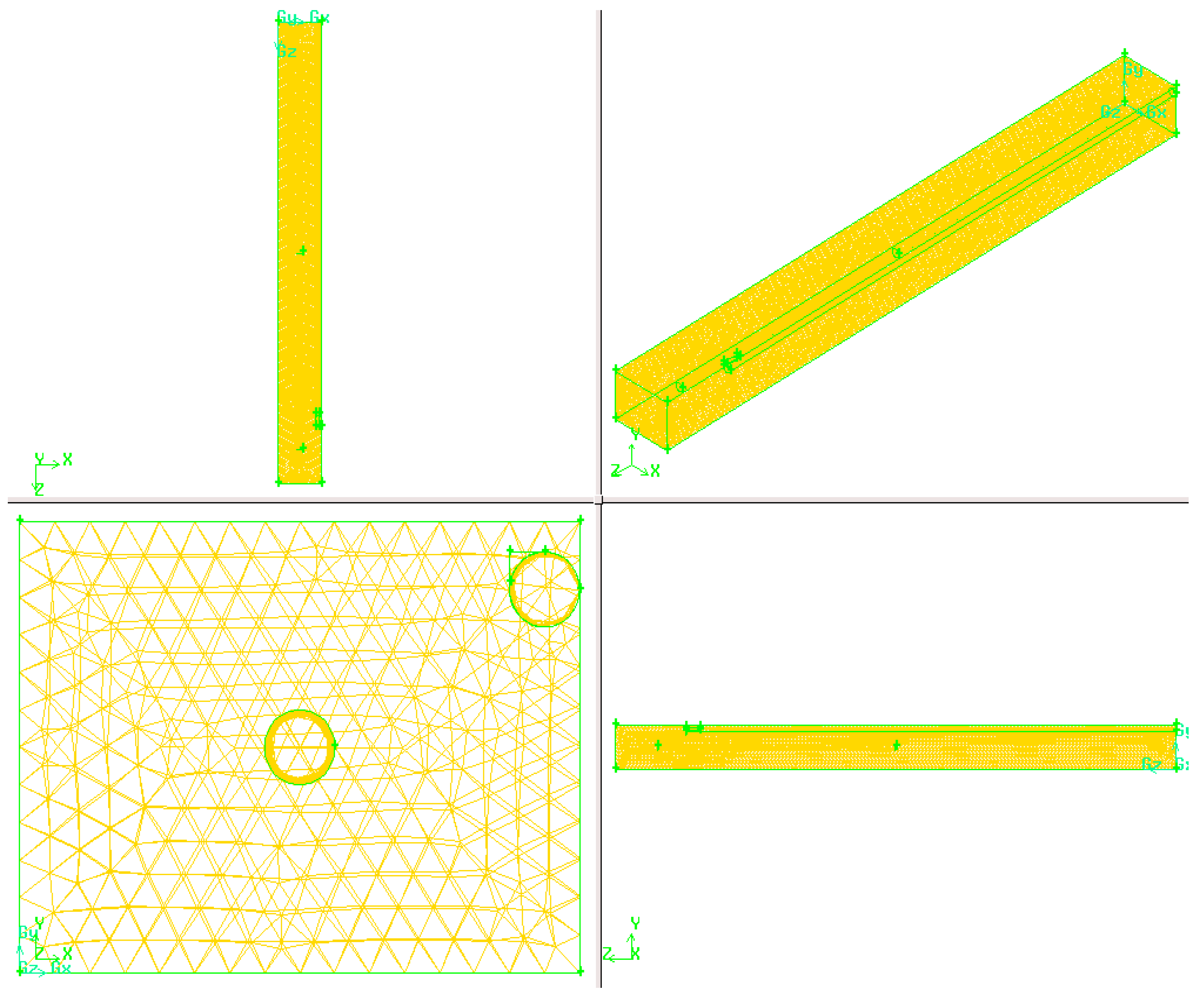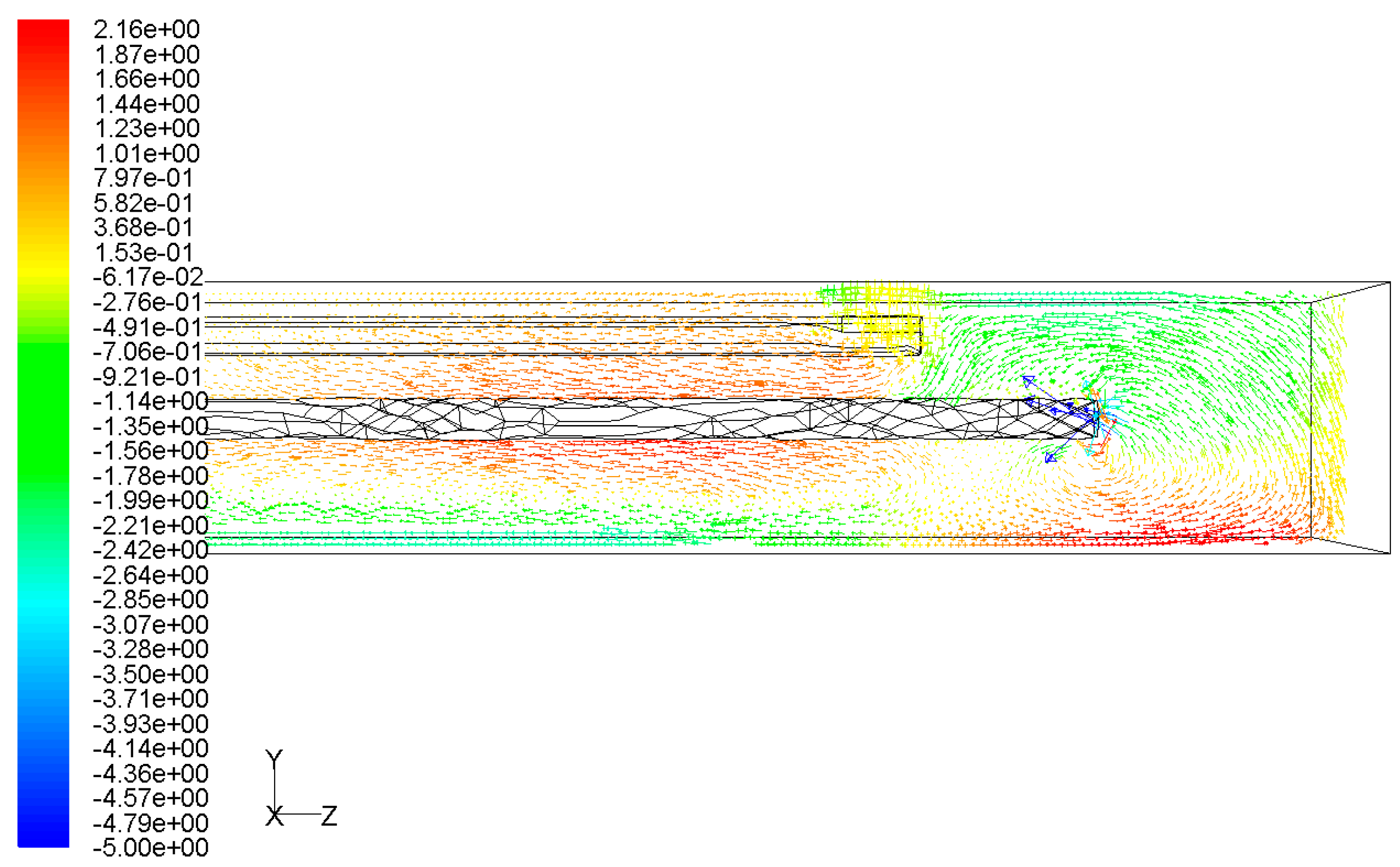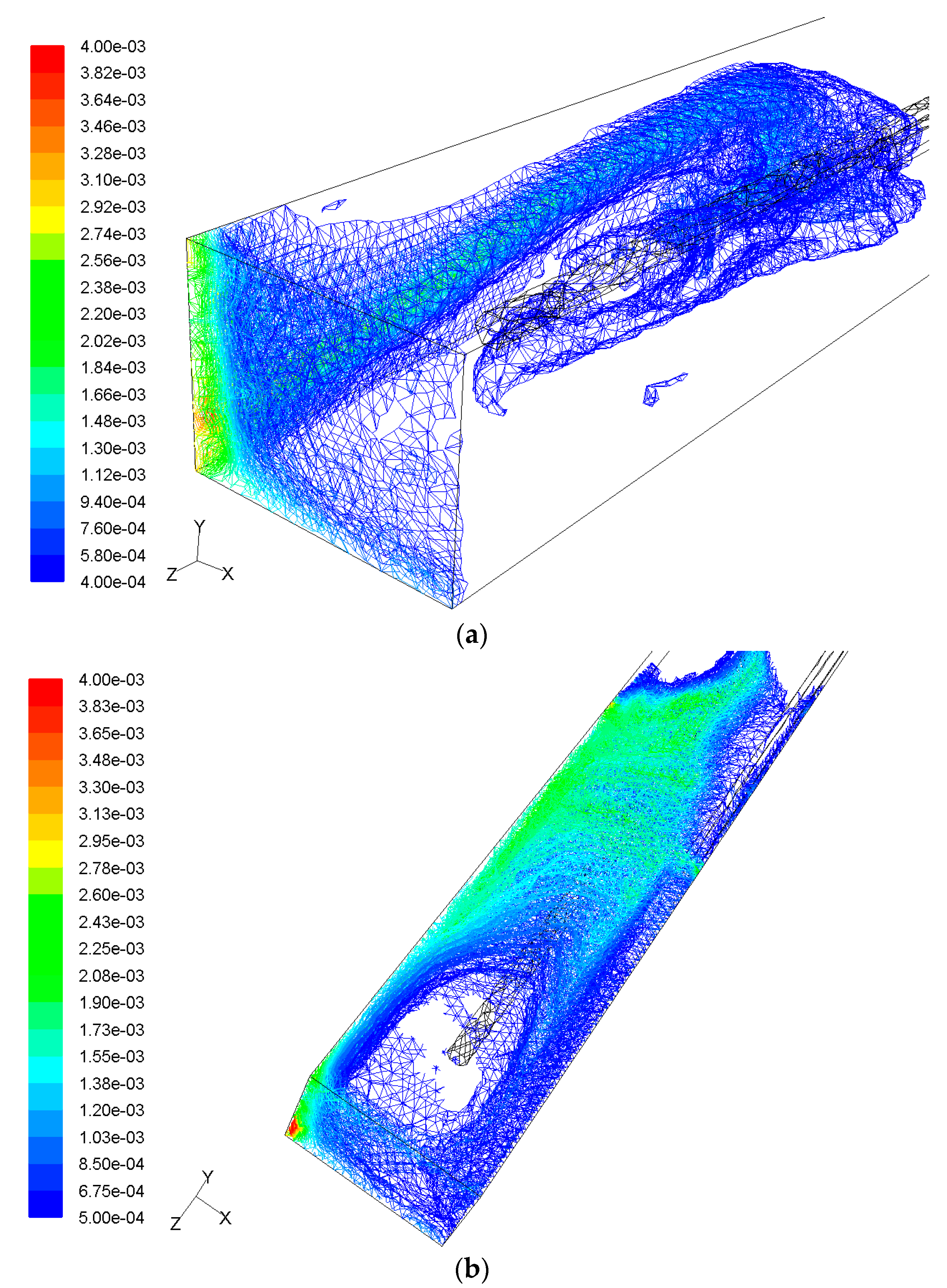Numerical Study of the Respirable Coal Dust Removal Performance of a Vortex Ventilation System at an Excavation Face
Abstract
:1. Introduction
2. Model Description
2.1. Physical Model
2.2. Mathematical Model
2.3. Boundary Conditions and Numerical Schemes
3. Result and Discussion
3.1. Airflow Field Distribution
3.1.1. Long Blowing and Short Suction Ventilation System
3.1.2. Vortex Ventilation System
3.2. Coal Dust Distribution
3.2.1. Coal Dust Distribution under Two Ventilation Systems
3.2.2. Dust Concentration Comparison between Two Ventilation Systems
3.3. Limitations and Perspectives
4. Conclusions
Author Contributions
Funding
Acknowledgments
Conflicts of Interest
References
- Xu, G.; Chen, Y.; Eksteen, J.; Xu, J. Surfactant-aided coal dust suppression: A review of evaluation methods and influencing factors. Sci. Total Environ. 2018, 639, 1060–1076. [Google Scholar] [CrossRef] [PubMed]
- Ayoglu, F.N.; Acikgoz, B.; Tutkun, E.; Gebedek, S. Descriptive characteristics of coal workers’ pneumoconiosis cases in Turkey. Iran. J. Public Health 2014, 43, 389–390. [Google Scholar] [PubMed]
- Pollock, D.; Potts, J.; Joy, G. Investigation into dust exposures and mining practices in mines in the southern Appalachian Region. Min. Eng. 2010, 62, 44–49. [Google Scholar]
- Ross, M.; Murray, J. Occupational respiratory disease in mining. Occup. Med. 2004, 54, 304–310. [Google Scholar] [CrossRef] [PubMed] [Green Version]
- Weeks, J.L. Occupational health and safety regulation in the coal mining industry: Public health at the workplace. Annu. Rev. Public Health 1991, 12, 195–207. [Google Scholar] [CrossRef] [PubMed]
- Wang, Q.; Wang, D.; Wang, H.; Han, F.; Zhu, X.; Tang, Y.; Si, W. Optimization and implementation of a foam system to suppress dust in coal mine excavation face. Process Saf. Environ. Prot. 2015, 96, 184–190. [Google Scholar] [CrossRef]
- Ren, X.W.; Wang, M.D.; Kang, H.Z.; Lu, X.X. Engineering case report: A new method for reducing the prevalence of pneumoconiosis among coal miners: Foam technology for dust control. J. Occup. Environ. Hyg. 2012, 9, D77–D83. [Google Scholar] [CrossRef] [PubMed]
- Netting, D.I. Method for Reducing the Amount of Coal Dust in the Environment Surrounding Coal Mining. U.S. Patent 4,380,459, 19 April 1983. [Google Scholar]
- Lee, S.-M.; Lee, J.-W. A New Local Ventilation System Using a Vortex Flow Generated with a Finned Rotating Annular Disk. ASHRAE Trans. 2005, 111, 149–158. [Google Scholar]
- Collecutt, G.; Humphreys, D.; Proud, D. CFD simulation of underground coal dust explosions and active explosion barriers. In Proceedings of the 7th International Conference on CFD in the Minerals and Process Industries CSIRO, Melbourne, Australia, 9–11 December 2009. [Google Scholar]
- Hu, S.; Feng, G.; Ren, X.; Xu, G.; Chang, P.; Wang, Z.; Zhang, Y.; Li, Z.; Gao, Q. Numerical study of gas–solid two-phase flow in a coal roadway after blasting. Adv. Powder Technol. 2016, 27, 1607–1617. [Google Scholar] [CrossRef]
- Hu, S.; Wang, Z.; Feng, G. Temporal and Spatial Distribution of Respirable Dust After Blasting of Coal Roadway Driving Faces: A Case Study. Minerals 2015, 5, 679–692. [Google Scholar] [CrossRef] [Green Version]
- Geng, F.; Luo, G.; Zhou, F.; Zhao, P.; Ma, L.; Chai, H.; Zhang, T. Numerical investigation of dust dispersion in a coal roadway with hybrid ventilation system. Powder Technol. 2017, 313, 260–271. [Google Scholar] [CrossRef]
- Toraño, J.; Torno, S.; Menéndez, M.; Gent, M. Auxiliary ventilation in mining roadways driven with roadheaders: Validated CFD modelling of dust behaviour. Tunn. Undergr. Space Technol. 2011, 26, 201–210. [Google Scholar] [CrossRef]
- Ren, T.; Wang, Z.; Cooper, G. CFD modelling of ventilation and dust flow behaviour above an underground bin and the design of an innovative dust mitigation system. Tunn. Undergr. Space Technol. 2014, 41, 241–254. [Google Scholar] [CrossRef]
- Wang, Z.; Ren, T. Investigation of airflow and respirable dust flow behaviour above an underground bin. Powder Technol. 2013, 250, 103–114. [Google Scholar] [CrossRef]
- Glushkov, D.; Strizhak, P.; Vysokomornaya, O. Numerical research of heat and mass transfer during low-temperature ignition of a coal particle. Therm. Sci. 2015, 19, 285–294. [Google Scholar] [CrossRef]
- Zhang, Z. Study and Application of Integrated Eddy Current Ventilation and Dust Removal System in Mechanized Excavation Face. Master’s Thesis, China University of Mining and Technology, Xuzhou, China, 2010. [Google Scholar]
- Blazek, J. Computational Fluid Dynamics: Principles and Applications; Butterworth-Heinemann: Oxford, UK, 2015. [Google Scholar]
- Sokolichin, A.; Eigenberger, G.; Lapin, A.; Lübert, A. Dynamic numerical simulation of gas-liquid two-phase flows Euler/Euler versus Euler/Lagrange. Chem. Eng. Sci. 1997, 52, 611–626. [Google Scholar] [CrossRef]
- Van der Hoef, M.; Ye, M.; van Sint Annaland, M.; Andrews, A.; Sundaresan, S.; Kuipers, J. Multiscale modeling of gas-fluidized beds. Adv. Chem. Eng. 2006, 31, 65–149. [Google Scholar]
- Macı́as-Garcı́a, A.; Cuerda-Correa, E.M.; Dı́az-Dı́ez, M. Application of the Rosin-Rammler and Gates-Gaudin-Schuhmann models to the particle size distribution analysis of agglomerated cork. Mater. Charact. 2004, 52, 159–164. [Google Scholar] [CrossRef]


















| Model | Parameter |
|---|---|
| Solver | Pressure-Based |
| Implicit | |
| Steady | |
| Viscous Model | k-epsilon |
| Energy | off |
| Solution Controls | Parameters |
|---|---|
| Pressure-Velocity Coupling | SIMPLEC |
| Pressure Discretization | Standard |
| Discretization | Second Order Upwind |
| Convergence criterion | 0.001 |
| Boundary | Boundary Conditions | Parameter |
|---|---|---|
| Blowing duct | Inlet Boundary Type | Velocity-inlet |
| Inlet Velocity (m/s) | 22 | |
| Hydraulic Diameter (m) | 0.5 | |
| Turbulence Intensity | 3.0% | |
| Suction duct outlet | Outlet Boundary Type | Velocity-outlet |
| Outlet Velocity (m/s) | 17 | |
| Hydraulic Diameter (m) | 0.5 | |
| Turbulence Intensity | 3.1% | |
| Roadway outlet | Outlet Boundary Type | Outflow |
| Wall | Shear Condition | No Slip |
| Total Dust | Respirable Dust | ||
|---|---|---|---|
| Diameter (μm) | Mass Fraction | Diameter (μm) | Mass Fraction |
| 1~10 μm | 0.05 | 1~2 μm | 0.05 |
| 10~30 μm | 0.10 | 2~3 μm | 0.15 |
| 30~50 μm | 0.35 | 3~4 μm | 0.30 |
| 50~70 μm | 0.30 | 4~5 μm | 0.30 |
| 70~90 μm | 0.15 | 5~6 μm | 0.15 |
| 90~100 μm | 0.05 | 6~7.07 μm | 0.05 |
| Boundary Condition | Boundary |
|---|---|
| Reflecting | Roadway wall Roadway roof Duct wall |
| Trap | Roadway floor |
| Escape | Duct inlet Duct outlet Roadway inlet Roadway outlet |
© 2018 by the authors. Licensee MDPI, Basel, Switzerland. This article is an open access article distributed under the terms and conditions of the Creative Commons Attribution (CC BY) license (http://creativecommons.org/licenses/by/4.0/).
Share and Cite
Liu, X.; Chang, P.; Wang, E.; Zhang, Z.; Yang, S. Numerical Study of the Respirable Coal Dust Removal Performance of a Vortex Ventilation System at an Excavation Face. Energies 2018, 11, 2449. https://doi.org/10.3390/en11092449
Liu X, Chang P, Wang E, Zhang Z, Yang S. Numerical Study of the Respirable Coal Dust Removal Performance of a Vortex Ventilation System at an Excavation Face. Energies. 2018; 11(9):2449. https://doi.org/10.3390/en11092449
Chicago/Turabian StyleLiu, Xiaofei, Ping Chang, Enyuan Wang, Zhenguo Zhang, and Shuai Yang. 2018. "Numerical Study of the Respirable Coal Dust Removal Performance of a Vortex Ventilation System at an Excavation Face" Energies 11, no. 9: 2449. https://doi.org/10.3390/en11092449





